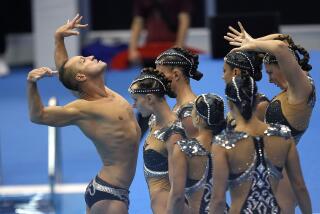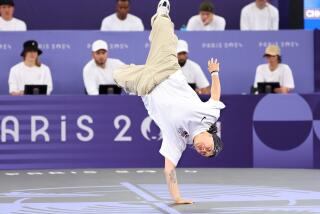Scientists Keep Probing as Olympians Push Performance Limits
Sprinters faster than a thoroughbred horse. Female swimmers with the shoulders and swagger of linebackers. Weightlifters generating enough energy in a single clean-and-jerk to illuminate your house--and your neighbor’s.
World records fell in bunches at the Sydney 2000 Olympic Games.
The athletes’ performances were the product of superb genes, hard work and, increasingly, science.
Years ago, scientists--physiologists, kinesiologists, nutritionists, biomechanists, even physicists-- began applying their knowledge to athletes. As a result, practicing a sport for hours is no longer enough to win.
In the lungs of cyclists, they measure the maximum oxygen intake in milliliters per kilogram of weight per minute.
In the fast-twitch muscle cells of a rower, they determine the use of energy-producing adenosine triphosphate and the buildup of fatigue-inducing lactic acid.
Using computers, videotape and sensors, they streamline the trajectory of a weightlifter’s hoist or a gymnast’s vault.
Combined with more than 1,000 hours of intensive training a year, how much might science improve an Olympian’s peak performance?
Maybe 1%.
That’s often the difference between a gold medal and a silver. For now.
But are we reaching the upper limits of athletic performance? Are the world’s top athletes, in the words of British biochemist Guy C. Brown, “doomed to battle . . . over ever-diminishing fractions of seconds and centimeters?”
Or can more science help Olympic athletes improve significantly?
Both, Brown says. In a study published in the journal The Sciences, Brown reports athletes’ performances have improved steadily since 1900.
For example, the record time in the men’s 1,500-meter run has improved by about 10 seconds every quarter-century. Men historically have outperformed women in most events, but the gap is narrowing. In a 1992 UCLA study, scientists predicted that women would outrun men, especially in endurance races such as the marathon, by 2035.
By 2020, the editors of The Sciences predict, women will run the 10,000-meter run a full minute faster than men.
But humans may soon reach the limits of physical fitness, Brown argues.
The overall limiting factor for athletes is the heart’s ability to pump more freshly oxygenated blood through miles of vessels.
“If it could push more blood through the body, an athlete could run, swim, row or ride a bicycle faster than usual,” Brown said.
Brown says athletic improvements in the 21st century probably will depend on scientific and technological gains--among them better equipment, surgical enhancements such as more flexible tendons, even genetic engineering for faster-acting muscles, higher oxygen absorption and faster blood circulation.
“Future limits to athletic performance will be determined less by the innate physiology of the athlete than by technological advances and the evolving judgment on where to draw the line between what is ‘natural’ and what is artificially enhanced,” Brown said.
For now, there are no clear answers to the performance questions Brown raises. Too many athletes. Too much history. Too many complicating factors.
At Sydney, scientists keenly watched the women’s pole vaulting, which debuted this year. Stacy Dragila won the gold medal, but she failed to equal her world record of 15 feet 2.25 inches. Few researchers and coaches believe it will remain there as faster, stronger women compete.
“The women’s record is likely to improve quite a bit,” said University of Texas physicist Cliff Froelich.
Pole vaulting, he explains, is an example of energy conservation. The athlete’s kinetic energy, or motion, is translated through the flexible fiberglass pole into the potential energy of the jump height.
His prediction: 17.5 feet. That would be more than two feet above the current record, or an astonishing 15% improvement.
Dave Nielson, Dragila’s coach at Idaho State, also expects above-17-foot vaults, though he is among experts who doubt women’s vaults will exceed the men’s record of 20 feet 1.75 inches. Physics favors the men, who are stronger and generally taller.
Records fell at Sydney’s Aquatic Center too. The men’s surge was led by Australian sensation Ian Thorpe, the “Thorpedo” whose shoe size (18) exceeds his age (17). He won three gold medals and a silver before the first week was over, and set two world records.
Pieter van den Hoogenband of the Netherlands became the first man to crack the 48-second barrier in the 100-meter freestyle.
Scientists aren’t particularly impressed by the men.
“The men’s records are falling by a whisker,” said physiologist Joel Stager of Indiana University. “They are swimming exactly as predicted.”
And the women?
“The women are completely different,” Stager said. “It is almost alarming.”
The women’s performances in the pool defy biochemist Brown’s assertion that athletes’ margins of victory are narrowing as their conditioning peaks.
No woman swam faster than Inge de Bruijn of the Netherlands. She set world records in the 100-meter freestyle and butterfly and the 50-meter freestyle.
“Someone asked me what my limits are,” De Bruijn said. “I don’t know. But the year 2000 is definitely my year.”
Or consider Misty Dawn Hyman in the women’s 200-meter butterfly. The Arizona native swam a full three seconds faster than her previous best time to win gold.
But scientists say the proof of phenomenal performance lies with the losers. The key measurement is “field time”--the average time of all the competitors.
In six of of the first eight women’s swimming events, Stager says, the average time of the finalists was significantly faster than predicted.
In the women’s 200-meter butterfly, Stager had predicted an average field time of 2:10.01. It averaged 2:08.19.
Women swam the 200-meter freestyle 0.49 seconds faster than predicted. They swam the 100-meter breaststroke 0.92 seconds faster.
“Rarely do you see such huge changes, especially if a sport has been around for a while,” Stager said. “If we were seeing it with both the men and the women, I’d think we did something wrong. But we’re seeing it with women only.”
What’s going on? Stager will spend the next four years pondering the question. But already he has some promising theories.
He believes training alone cannot account for the improvement. Sure, De Bruijn lifts weights. But so do the others.
One factor could be age. The female swimmers are more mature, physically and emotionally. In 1988 the average age of U.S. female swimmers was 15. Now it is nearly 20.
And economics. Top-name Olympians like Dara Torres are attracting lucrative endorsements.
“Torres can afford to be a swimmer,” Stager said. “That’s a huge advantage.”
Nor can the illegal use of performance-enhancing drugs be ruled out, Stager says. Drug-testing in Sydney was the Olympics’ most rigorous yet, including more than 2,000 random tests. But they couldn’t directly identify some of the most effective biochemical advancements, including the use of human growth hormone and erythropoietin, which stimulates red blood cell production.
“Drugs remain a distinct possibility,” Stager said.
One factor that Stager dismisses in the swimming events is the new style of swimsuit made to simulate fish skin to reduce drag in the water. Medal winners wore a variety of suits, new and old.
Harder to measure, but equally important, is the mental side of sports. It is here--especially among the female gymnasts--that scientists have noticed a significant decline in performance. Experienced gymnasts repeatedly fell, stumbled and slipped.
Tension and doubt trigger biochemical changes that interrupt the muscles’ automatic motor response, the “muscle memory” honed by years of practice.
“You have to be enjoying it,” said Boston University sports psychologist Leonard Zaichowsky. “Just a small amount of excess tension results in failure when scores are based on fractions of a point.”
To gain an edge, most elite athletes visualize a perfect race or routine before competing.
“Visualization actually gets the muscles firing,” Zaichowsky said. “It gives the body a rehearsal.”
Few athletes dream of victory more vividly than U.S. swimmer Megan Quann. In her bedroom in Puyallup, Wash., Quann would lie with a stopwatch in her hand and imagine herself touching the wall ahead of defending champion Penny Heyns of South Africa.
“I can see the tiles on the bottom of the pool,” the high school junior recalled. “I can taste the water. I can hear the crowd.”
In the 100-meter breaststroke finals, Quann used a strong kick to defeat Heyns by a half-second, a huge margin.
She won the gold medal. For real.
Imagine that.
More to Read
Go beyond the scoreboard
Get the latest on L.A.'s teams in the daily Sports Report newsletter.
You may occasionally receive promotional content from the Los Angeles Times.






